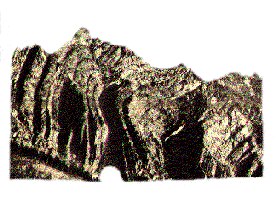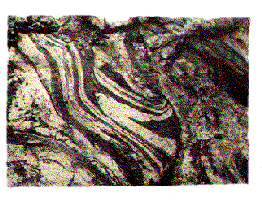


Rocks
The solid material that makes up the earth's crust. The entire solid surface of the earth is made up of rocks of various types. Soil, sand, and other loose materials are not usually considered to be rock, although they are derived principally from rocks.
Virtually all rocks are composed of one or more minerals, which are natural substances that have characteristic properties and more-or-less specific chemical compositions. The largest single group of minerals in the rocks of the earth's crust are silicates, which consist of silicon, oxygen, and one or more of the metals found most frequently in silicates which are aluminum, sodium, magnesium, calcium, and potassium.
The scientific study of rocks and their relationship to one another -- and to the earth as a whole -- is called geology. A geologist who specializes in the study of rocks themselves is a petrologist; an expert in minerals is a mineralogist.
Rocks are extremely varied in their appearance and general properties. Petrologists often identify and classify rocks on the basis of three main characteristics: texture, structure, and composition. Texture refers to the shape, size, and appearance of the individual particles in rock. Structure refers to the overall arrangment and appearance of rock in its natural setting. Composition refers to the minerals contained in the rock.
By determining the kinds and abundances of minerals in a sample of rock, a scientist can often identify the rock. The color of a rock sample is often a clue to its mineral composition; red and brown rocks, for example, may owe their color to the presence of iron-rich minerals. Density (weight of a given volume) is another aid in identifying composition; relatively dense rock may contain minerals that are rich in heavy metals such as lead.

There are three major classes of rocks, grouped according to the way in which they are formed: igneous, sedimentary, and metamorphic.
Metal ores are often found near masses of igneous rock. These ores were originally produced by the colling of magma that had a metallic content, or by the chemical interaction of other rocks with cooling magma.
IGNEOUS ROCK
Four samples of rock formed underground by heating and cooling: upper left: grantite; upper right: obsidian, a noncrystalline rock fromed from lava; lower left: granite porphyry, with large crystals of feldspar; lower right: felsite, an extremely fine-grained igneous rock.


SEDIMENTARY ROCK
These uplifted and folded strata in the Rocky Mountains of Montana originated as layers of sediment at the bottom of an ancient sea.


METAMORPHIC ROCK
This outcrop of banded gneiss in Massachusettes shows the layered, or foliated, appearance that is typical of some metamorphic rocks. The gneiss was formed when underground heat and pressure seperated and aligned the light and dark minerals in a block of granite. The area shown in the photo is about seven feet (about 2 meters) from top to bottom.

